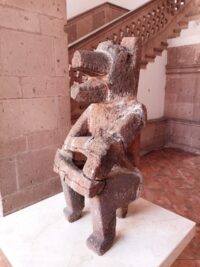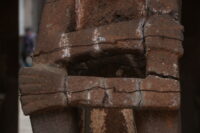 After a multi-year legal battle, the Republic of Mexico has recovered a nationally important pre-Hispanic statue of a Coyote Man. The basalt statue is 4.5 feet high and 1.5 feet wide and depicts a man with a coyote head sitting on a stool, his arms crossed over his knees. It’s not certain if it depicts an anthropozoomorphic figure or a man wearing a coyote headdress. It likely dates to the Postclassic period, around 1450.
After a multi-year legal battle, the Republic of Mexico has recovered a nationally important pre-Hispanic statue of a Coyote Man. The basalt statue is 4.5 feet high and 1.5 feet wide and depicts a man with a coyote head sitting on a stool, his arms crossed over his knees. It’s not certain if it depicts an anthropozoomorphic figure or a man wearing a coyote headdress. It likely dates to the Postclassic period, around 1450.
This iconography is typical of the Tarascan culture but its size makes it exceptional. About a dozen coyote men have been found in the former capitals of the Tarascan kingdom Ihuatzio and Tzintzúntzan (most of them from Ihuatzio which means “place of the coyotes”), but they range in height from 15 and 20 inches. Of all of the known surviving Tarascan sculptures, only the chacmools (reclining figures of men holding offerings) of Ihuatzio are larger than the newly-revealed Coyote Man.
The sculpture was discovered 30 years ago in a private home during drainage works in the town of Tacámbaro de Codallos in central Mexico. The Hernández family did not report the find. They just kept it in their garage for three decades. According to Mexico’s Federal Law on Monuments and Archaeological, Artistic and Historical Zones, all pre-Hispanic objects found in the country are the property of the state. Private individuals may be allowed to keep a moveable artifact only if they receive a concession for use from the government granting them custody (not ownership).
 It has not been gently handled. There are fractures and breakages either when it was pulled from the ground by heavy equipment or in later moves. It is currently being held together by a pair of rusted metal wires wrapped around its arms.
It has not been gently handled. There are fractures and breakages either when it was pulled from the ground by heavy equipment or in later moves. It is currently being held together by a pair of rusted metal wires wrapped around its arms.
When its existence was finally revealed, Mexico’s National Institute of Anthropology and History (INAH) took the matter to the courts. The case generated some controversy because the locals did not want to see such a culturally important object taken out the city, even though it had never been viewable to the public stashed in the garage. Ultimately, the family signed a quitclaim and the sculpture has now been moved to the INAH Michoacán Center where it will receive extensive conservation.
INAH said its specialists are now assessing the state of the work, as a series of fractures were sustained during its rough extraction by the municipality. Once the conservation is executed, it’s expected to “have a place of honor within the archaeological collection of the community museum of the city council,” according to the institute.
just watched a segment on the stone balls of Bosnia, well I know of a simulator site located in Pennsylvania at a place called St. Peters village, just east of Lancaster County. you need to check it out!